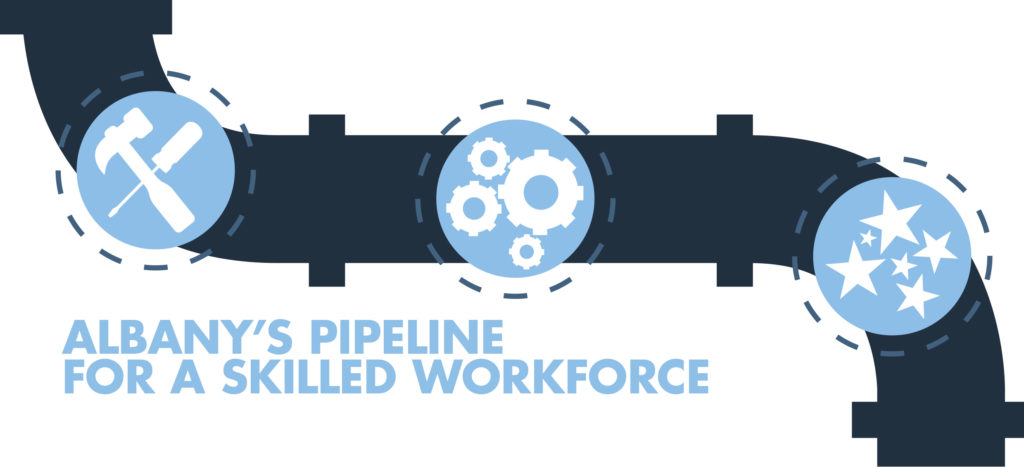Albany’s Pipeline for a Skilled Workforce

Janet Steele, president of the Albany Area Chamber of Commerce, is working with community partners to lead an initiative that addresses her region’s skilled worker shortage. The collaborative effort, called Pipeline, provides technical education and specialized training to high school and community college students to prepare them for the workforce. Regardless of a student’s educational plans, Pipeline provides them with a career track. The program helps students visualize a future career, and manufacturers appreciate the benefits of a skilled workforce.
A Pipeline to success for Oregon students
Not unlike other areas of the country, Linn County, home to the Albany Area Chamber, faces a shortage of skilled workers. The region boasts strong manufacturing, aviation, and food industries, and is famous as a major producer of airplane parts and freeze-dried foods. These industries require highly technical skills; and while workers need education and training, they don’t necessarily need a four-year degree.
The severity of the shortage became evident four years ago when the Albany Area Chamber hosted a luncheon for manufacturers aimed at addressing their biggest challenges. Those issues were “unanimously around workforce, especially the shortage of skilled workers,” says Steele. In fact, more than 1,100 jobs were required by just the five leading manufacturers, due to a combination of an anticipated increase in orders, baby boomer retirements and natural attrition. “Which, in a town of 52,000, is very significant,” says Steele.
The chamber subsequently collaborated with its local public schools and nearby Linn-Benton Community College (LBCC) to assess how it could best help meet their needs. Focus groups of parents, teachers, students and industry employees were convened to tackle the problem. These conversations led to an agreement that a formalized program was needed to address the skilled worker shortage. Six of the largest manufacturers in the region and Samaritan Health Services volunteered about 70 percent of the startup funding for the initiative, which became known as Pipeline. Additional funding was provided by school systems in both Linn and Benton counties, Linn-Benton Community College, and Linn County.
Steele hired a full-time workforce development director who serves as a liaison between employers and school districts, coordinating programs for middle and high school students. An advisory council, consisting of industry leaders and key funders, meets regularly to monitor the program’s performance. Because of the importance of reaching students at an early age, Pipeline established middle school career clubs, in which industry champions volunteer to work with kids after school on activities involving robotics, for example, or a 3-D printer. Among the series of programs and events to help engage students:
• Annual Women in Manufacturing Day, on which about 60 high school students visit LBCC to learn about different occupations like welding and mechatronics, and can try out the equipment.
• National Career and Technical Education Signing Day take place annually in February, with about 60 high school seniors expected this year. Inspired by the college athletic signing events, the day is used to promote LBCC’s CTE (career and technical education) programs, and allows graduating seniors to commit to enrolling and to guarantee their spot. Some guarantees even come with a partial scholarship.
• Community college campus showcases. It’s not unusual for 200 eighth-graders to show up, drawn by the opportunity for a hands-on experience that these programs offer. “Hands-on is the key to actively engaging students. They’re not being asked to simply go on a tour,” comments Steele.
• Summer camps. Pipeline offers a “Think it/Make it” summer
camp for middle schoolers and has scheduled camps for high schoolers as well, including a weeklong camp at LBCC and another at nearby Oregon State University.
Pipeline enables the chamber and industry representatives to showcase these opportunities to teachers, parents and the community. For example, teachers and school staff are periodically invited to tour a participating employer’s facilities. The program’s marketing efforts focus on reinforcing the fact that there are good area jobs that don’t require a four-year degree. It also aims to combat a lack of awareness about how skill sets developed in the classroom relate to actual jobs.
The city council and local legislature are major supporters, with the city of Albany chipping in $2.9 million in economic development funds to LBCC after the chamber and manufacturers identified the need to bring classrooms up to date. (The money will be used for equipment needed by CTE students.) Linn County has also invested in the program. “Filling these jobs is expensive, so our goal with this program is to help employers fill them more easily,” says Steele. The classroom component is critical to the program’s success, as Pipeline works with high schools and LBCC to revamp their CTE programs and ensure students receive comprehensive training. “We needed to have this partnership,” says Steele. “It couldn’t be done if they weren’t willing to listen to what employers’ needs are, and restructure classes based on those needs.” Pipeline’s early success is demonstrated by the number of students enrolled in the welding, machine tooling and mechatronics programs at LBCC, which has tripled since the program’s inception. Especially popular is the two-year mechatronics program, a multidisciplinary field that combines electronics, computer engineering, and mechanical engineering. Manufacturers are happy, too. All who agreed to an initial three-year commitment have already committed to another three-year cycle. They’re now hiring students who were in high school when the program was launched.
Another sign of Pipeline’s success: this past fall, health care employers asked for help to address their expected industry shortages. While the industry came on board as a major funder at the very beginning, hospitals now realize that they too have shortages that need addressing — and they’ve seen how well the program has worked for manufacturers. Steele acknowledges that the work done in the past three years has made just a dent and that there’s still much more to be done. But she’s encouraged by the progress so far and expects the upward trend to continue. Currently, there are no plans to seek state funding. Steele says she is pleased to not be “reliant upon” the government. Her hope is that funding will continue to be industry-driven because the program is “much nimbler with the flexibility we have through our funding sources.”
The pipeline is nevertheless attracting attention from state officials. At the next advisory council meeting, representatives from the state government will be in attendance. Word of the program’s success has gotten out, and state officials want to know if it can be replicated. “Workforce development around CTE and STEM is extremely important to the area and to our local employers,” says Steele “We’re creating our future workforce locally.”
By Holly South
Holly South is a policy associate at the
National Conference of State Legislatures.

